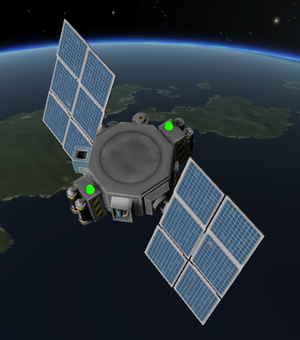Electric charge/pl
Elektryczność jest używana przez bezzałogowe moduły sterujące, lampy, koła do łazików, silnik jonowy i instrumenty badawcze. Można ją przechowywać w bateriach. Raczej niewielką jej ilość posiadają też wszystkie moduły sterujące (załogowe i bezzałogowe). Produkują ją silniki odrzutowe, część silników rakietowych, panele słoneczne i radioizotopowy generator termoelektryczny.
Contents
Produkcja elektryczności
Silniki rakietowe
Część silników rakietowych działając produkuje mnóstwo energii elektrycznej. Dzieje się to jednak tylko, gdy są aktywne.
| Nazwa modelu | Wytwarzana ilość prądu |
|---|---|
| LV-T30 Liquid Fuel Engine | 60/s |
| LV-T45 Liquid Fuel Engine | 60/s |
| Rockomax "Poodle" Liquid Engine | 60/s |
| Rockomax "Mainsail" Liquid Engine | 180/s |
Z silników rakietowych tylko w/w modele produkują prąd elektryczny.
Silniki odrzutowe
Silniki te, tak samo jak rakietowe wytwarzają elektryczność tylko, gdy są uruchomione.
| Nazwa modelu | Ilość wytwarzanego prądu |
|---|---|
| Basic Jet Engine | 48/s |
| TurboJet Engine | 60/s |
Panele fotowoltaiczne (słoneczne)

Panele słoneczne są bardziej zautomatyzowanymi i kompaktowymi źródłami energii. Nie działają jednak bez Słońca, więc na nic nie zdadzą się nocą, ani podczas zaćmienia.
Wszystkie oprócz paneli OX-STAT muszą zostać rozwinięte, aby działać. Takie panele są bardzo delikatne i rozpadają się podczas doświadczania oporu aerodynamicznego. Z tego powodu zalecane jest zwinięcie ich przed wejściem w atmosferę.
Ilość wytwarzanej przez nie energii zależy od ustawienia względem Słońca, lecz wszystkie (oprócz w/w paneli OX-STAT samemu ustawiają się w jego stronę.
They generate more electricity the closer to the Sun they are located. However, they do not currently use the inverse-square law. Rather, they follow a spline curve of 3 piecewise cubics defined from 4 points:
| Dystans (m) | Moc | Miejsce |
|---|---|---|
| 0 | 10x | |
| 13,599,840,256 | 1x | Kerbin's orbit |
| 68,773,560,320 | 0.5x | Jool's semi-major axis |
| 206,000,000,000 | 0x | Almost 3x Jool's orbit |
Due to their unreliable nature, it is recommended to have some energy storage as a buffer (see below) when supplying a craft solely with solar panels.
Radioisotope battery
The PB-NUK Radioisotope Thermoelectric Generator is a constant and reliable source of energy which doesn't require direct sunlight and is much more resistant to atmospheric drag than solar arrays. Unfortunately it has a very unpractical shape and generates less energy per kg mass than solar panels under normal conditions. Also, they don't look nearly as cool as solar panels.
Storing energy
A probe command pod can only store 5 units of energy which keeps it alive for not even 3 minutes. To survive longer without energy supply, to deal with peak loads (which often happen when using ion engines) or to bridge time gaps when solar panels aren't usable, batteries can be used to store more energy.
There is the circular Z-500 Rechargable Battery Bank with 500 units of energy designed to be used as a rocket segment and the Z-100 and Z-400 with 100 and 400 units respectively which are designed to be mounted on the outside of a vessel. The Z-100 and Z-400 store twice as much charge per kg of mass, but are less elegant to place.
Manned command pods also store 50 units of energy per crew member maximum capacity. But neither do they consume energy nor do they require any energy to function.
All energy storage available to a craft is fully loaded at launch.